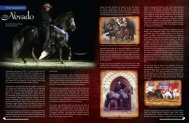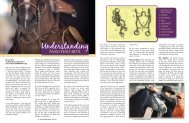Mounting and Dismounting - Paso Fino Horse Association
Mounting and Dismounting - Paso Fino Horse Association
Mounting and Dismounting - Paso Fino Horse Association
You also want an ePaper? Increase the reach of your titles
YUMPU automatically turns print PDFs into web optimized ePapers that Google loves.
36 • PASO FINO HORSE WORLD • jANuARy 2012<br />
to pull too much on the horse’s mane or the saddle, your best<br />
solution would be to use a mounting block.<br />
If your horse tries to move when you mount, keeping the left rein<br />
tighter will cause the horse to turn around you. Most horses will<br />
try a few steps, find themselves in a tight turn, <strong>and</strong> then stop. If<br />
you are in the middle of the mount <strong>and</strong> balanced over the stirrup,<br />
you should be able to wait until your horse stops his feet <strong>and</strong> then<br />
finish your mount. Keep holding the left rein tighter until you are<br />
securely seated in the saddle <strong>and</strong> have both h<strong>and</strong>s on the reins.<br />
never use a right h<strong>and</strong> turn when mounting from the left, as this<br />
pushes you away from the horse’s body, thereby causing you to<br />
lose balance <strong>and</strong> control.<br />
If your saddle slides, there are a few things you could try. Make<br />
sure before you mount that your right hip is close to the horse so<br />
that you can push straight up <strong>and</strong> can balance over the top of the<br />
saddle. If you st<strong>and</strong> farther away from the horse, you won’t have<br />
the power to get up smoothly <strong>and</strong> you’ll pull the saddle sideways.<br />
you’ll also have to bounce off your right foot several times, which<br />
creates the possibility of a misstep. you may need to use a<br />
breastcollar to keep your saddle in place, especially if you have<br />
a horse with low or round withers. you should also check your<br />
girth to make sure it isn’t too stretchy, especially if you have one<br />
with elastic ends that may have worn out. Some saddle pads may<br />
be slicker than others, so experiment with different pads to find<br />
one that has more grip. Finally, make sure you don’t put a coat<br />
conditioner or shining agent on your horse before riding, as these<br />
will make any saddle or pad slip on your horse’s back. using a<br />
mounting block will also put you in a better position to step onto<br />
your horse without moving the saddle.<br />
When it’s time to dismount, you essentially reverse the mounting<br />
process. We suggest you “wiggle” the saddle first, as this<br />
becomes a sign to the horse that the rider is going to dismount<br />
<strong>and</strong> allows the horse time to square its feet for balance. To<br />
dismount, put your reins in your left h<strong>and</strong> (taking a little hold of<br />
the left rein if necessary, for the same reason you did at mounting)<br />
with your left h<strong>and</strong> on the pommel or mane <strong>and</strong> your right h<strong>and</strong><br />
on the pommel. remove your right foot from the stirrup. Make<br />
sure your left foot is as far back in the stirrup as possible so that<br />
it won’t get caught if your horse tries to move or jump. St<strong>and</strong> up<br />
in the left stirrup, with weight on your right h<strong>and</strong>, <strong>and</strong> swing the<br />
right leg over your horse; again, keep your leg straight <strong>and</strong> make<br />
sure not to bump the horse’s hip or rump. Pause for a moment,<br />
<strong>and</strong> if all is safe, step down. An alternative dismount: after<br />
you swing your right leg over the horse <strong>and</strong> are st<strong>and</strong>ing in the<br />
left stirrup, you can lay your upper body over the saddle (you’ll<br />
have to move your right h<strong>and</strong> to the cantle), remove your left foot<br />
from the stirrup, <strong>and</strong> slide down, l<strong>and</strong>ing on both feet. This last<br />
technique is better if you have a very tall horse or otherwise can’t<br />
step down, or if you feel safer removing both feet from the stirrups<br />
to avoid the chance of getting hung up. after you dismount, you<br />
can loosen the girth slightly to take the saddle pressure off the<br />
horse’s back until you’re ready to untack.<br />
<strong>Mounting</strong> is literally the first step to riding <strong>and</strong> sets the tone for<br />
a good experience with your horse. <strong>Dismounting</strong> hopefully is<br />
the end of a good ride. If you start <strong>and</strong> stop with calmness <strong>and</strong><br />
control, you have set the stage for your horse to be calm <strong>and</strong><br />
controlled throughout. The way you leave your horse after a ride<br />
is the way he will come out the next time. We hope that these tips<br />
will be helpful to you. Be safe in all your riding.




